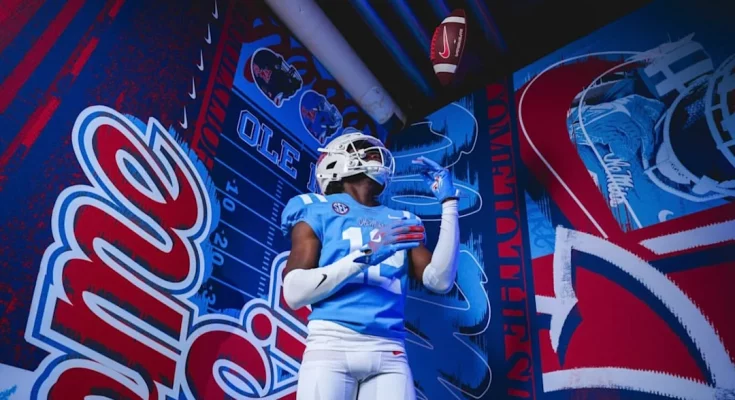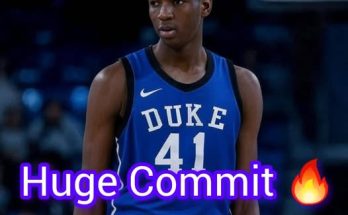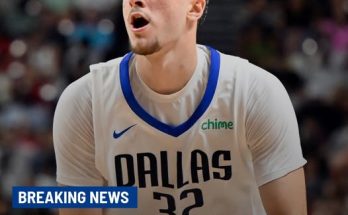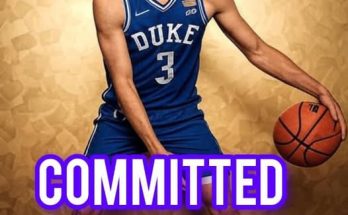Ole Miss football has been making waves this offseason, not just in its coaching staff shakeups but in its recruitment strategy that could redefine the trajectory of the program. With each new hire, the Rebels are signaling an aggressive push to elevate their profile in the SEC and beyond. But one question now dominates the conversation among college football insiders and fans alike: can Ole Miss’ latest coaching acquisition flip one of the nation’s top wide receivers from Auburn, a cornerstone of the Tigers’ recruiting success, and bring him to Oxford instead?
Recruiting in college football has always been a game of relationships, timing, and perception. Coaches invest countless hours building trust with prospects, their families, and high school programs, knowing that a single phone call or visit can sway a player’s future. Auburn’s wideout, currently ranked as the nation’s No. 2 at his position, has been firmly in the Tigers’ corner for months. His skill set, size, and speed have generated considerable buzz, and analysts consistently rank him as a potential game-changer at the next level. The commitment he has shown to Auburn underscores the magnitude of the task facing Ole Miss. Convincing such a high-profile recruit to reconsider a decision is never easy, especially when that player has invested time in Auburn’s system and established relationships with the coaching staff.
Enter Ole Miss’ latest hire, a move that has turned heads in SEC circles. The addition of this coach, whose reputation for developing elite wide receivers is widely recognized, injects new energy into the program’s recruiting strategy. This hire is not just a name on a staff list; it represents a calculated effort to attract top-tier talent, particularly at skill positions where the Rebels have struggled to consistently compete with the conference’s heavyweights. The coach brings a track record of mentoring players who have gone on to produce impressive collegiate careers and secure early-round NFL draft selections, a factor that cannot be overlooked by recruits who dream of playing at the next level.
One of the key strategies Ole Miss appears to be employing is leveraging the hire’s direct experience with elite receivers. By showcasing the coach’s prior successes, the program can make a compelling pitch to prospects that they will receive individualized attention and development opportunities that are unmatched elsewhere. For a wide receiver on the cusp of a major collegiate career, the promise of enhanced training, film study, and positional mentorship carries weight. This is particularly significant for a recruit of Auburn’s caliber, who is already receiving extensive attention from a host of SEC and national programs. The narrative Ole Miss is constructing centers around the idea that a move to Oxford could accelerate his path to the NFL while providing an environment tailored to maximize his potential.
Timing is another critical element in this equation. Ole Miss’ recruitment pitch comes at a point when the wideout is still finalizing his plans. While Auburn may have initially secured his commitment, college recruits often reassess decisions as new opportunities arise, especially when the programs vying for them demonstrate clear advantages. The presence of a respected wide receiver coach on the Ole Miss staff could be the tipping point, offering a unique value proposition that Auburn may not currently match. The Rebels’ ability to articulate this vision effectively during in-home visits, campus tours, and one-on-one conversations will likely play a pivotal role in influencing the recruit’s decision.
Beyond coaching, Ole Miss is investing heavily in facilities, technology, and player support systems to enhance its appeal. Modern training complexes, state-of-the-art video rooms, and advanced nutrition and wellness programs all contribute to a player’s decision-making process. These investments signal a commitment to excellence and create an environment that fosters both athletic and personal growth. For a top recruit, the combination of elite coaching and top-tier infrastructure makes a program increasingly difficult to ignore, especially if he feels he can make a more immediate impact at Ole Miss than at a crowded depth chart in Auburn.
Relationship-building remains at the core of successful recruiting, and Ole Miss appears poised to capitalize on this. Recruiting is more than statistics and highlights; it is about trust, vision, and personal connection. The new hire brings not only technical expertise but also credibility and rapport with high school coaches and recruiting networks, which can be instrumental in persuading a recruit to reconsider. The ability to communicate a personalized plan for the player, emphasizing where he fits within the team’s offensive scheme and how he can shine on the national stage, will likely resonate with both the athlete and his support system.
However, the challenge is formidable. Auburn has entrenched relationships and a strong program culture that has consistently produced elite talent. Flipping a recruit of this magnitude is not simply about presenting a better offer; it requires demonstrating that the move is strategically and personally advantageous. The Rebels must differentiate themselves in ways that go beyond on-field performance. They need to highlight the coaching staff’s vision, the developmental opportunities, and the potential for immediate impact, while addressing any concerns about adjusting to a new program. It is a nuanced endeavor that demands patience, precision, and persistence.
The national media’s attention on this potential flip further complicates the scenario. When a high-profile recruit is publicly linked to multiple programs, each conversation is scrutinized, and every visit is dissected for signs of wavering commitment. This pressure can either amplify interest in Ole Miss or solidify Auburn’s hold on the player. In this landscape, the Rebels must carefully manage public perception while continuing their behind-the-scenes efforts to build trust and present a compelling case. Missteps in communication or strategy could derail what might otherwise be a promising opportunity.
It is also worth noting the broader implications for both programs. A successful flip would signal Ole Miss’ rising prowess in recruiting, enhancing the program’s national reputation and sending a message to future prospects that the Rebels are capable of competing with SEC powerhouses. Conversely, Auburn’s ability to retain the commitment reinforces its standing as a dominant recruiting force in the conference, maintaining momentum in its pipeline of elite talent. The outcome of this recruitment battle has consequences beyond a single athlete; it reflects the strategic positioning and perception of two programs in one of college football’s most competitive landscapes.
While the process unfolds, insiders suggest that Ole Miss’ approach is methodical and highly tailored. Recruit visits are being structured to maximize exposure to the new coach’s methodology, the offensive scheme, and the program’s culture. Personal attention from head coaches, coordinators, and position mentors ensures that the recruit feels valued and understood. Each interaction is designed to reinforce the message that Ole Miss is not merely an alternative to Auburn but a destination that offers a distinct and compelling pathway to success.
Ultimately, whether Ole Miss can flip the nation’s No. 2 wide receiver from Auburn hinges on several intertwined factors: the credibility and influence of the new coaching hire, the ability to convey a personalized developmental plan, the program’s infrastructure and support, and the broader narrative about opportunity and impact. Recruiting at this level is rarely linear, and shifts in commitment can occur rapidly when prospects are presented with new information or perspectives that resonate with their long-term goals. The Rebels’ strategy seems calibrated to exploit precisely such moments, demonstrating both foresight and boldness.
The college football world will be watching closely over the coming weeks as visits, conversations, and official announcements unfold. Fans, analysts, and insiders alike understand that flipping a top recruit is a rare and impactful achievement. For Ole Miss, successfully swaying Auburn’s prized wideout would not only strengthen the roster immediately but also reinforce the program’s growing reputation as a destination for elite talent. For the recruit himself, the decision carries enormous weight, shaping his collegiate experience and potentially influencing his future professional prospects.
In a sport defined by strategy, preparation, and execution, recruiting battles often mirror the intensity of the game itself. The clash between Auburn and Ole Miss over this top-tier wide receiver is a prime example. It highlights how a single hire, if leveraged correctly, can shift dynamics, create opportunities, and force programs to adapt. It is a reminder that in college football, coaching decisions and recruitment efforts are deeply intertwined, and the outcomes can reverberate for years.
As the calendar advances toward signing day, all eyes remain on this high-stakes contest. Will Ole Miss’ newest coaching acquisition be the catalyst that convinces a nationally recognized talent to change course? Or will Auburn’s established relationships and program culture prove insurmountable? The answer will not only shape the immediate fortunes of both programs but also send a message about the power of strategic hires and recruitment ingenuity in one of the nation’s most competitive conferences.
For now, the suspense fuels speculation, debate, and anticipation. Every phone call, visit, and conversation matters. Every promise made and relationship nurtured could tip the balance. And in the world of college football recruiting, where careers and legacies are often decided before a single snap is played, the outcome of this recruitment duel will be remembered long after the dust settles on signing day. The stage is set, the players are in motion, and Ole Miss’ latest hire may just be the game-changer that determines whether the nation’s No. 2 wide receiver dons crimson and blue in Oxford instead of Auburn.



